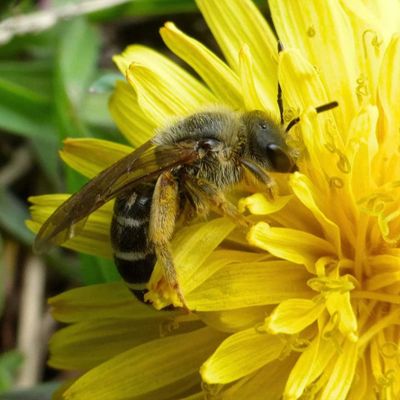Bugging the Northwest: Don’t sweat it – it’s just a thirsty bee

Sweat bees don’t sweat, but you do and they like it.
If one lands on your skin, it’s not there to sting you. It just wants a lap of your sweat.
Named after their unique attraction to the sodium and moisture found in perspiration, sweat bees are small and agile enough that we usually don’t notice them licking nourishment off our bodies.
If that’s got you thinking “Ew!” keep in mind that their main food source is not sweaty humans, but pollen and nectar. Similar to marathon runners drinking electrolyte beverages, these busy bees supplement their diet with perspiration.
And it’s a good thing our sweat isn’t the main part of their diet, because sweat bees are buzzing around everywhere. With more than 500 species known in North America and more than 25 in Washington, they “are important pollinators of crops and non-crop vegetation,” said entomologist Richard Zack of Washington State University.
The species photographed by Carl Barrentine at Spokane’s Dishman Hills Conservancy in May is Halictus rubicundus, Zack said. Found throughout much of the Northern Hemisphere and common in the Pacific Northwest, the females build nests in soft soil that typically face south to provide plenty of sun exposure, he explained.
H. rubicundus is commonly called the orange-legged furrow bee because of its orange furry back legs. Females use the stiff hairs on those legs to transport pollen back to their nests, according to Iowa State University’s BugGuide.
Even though they target our skin when we’ve been sweating, they’re not considered much of a threat when they alight. Although females will sting if pressed or squeezed, their tiny jab is reportedly painless.
“Light, ephemeral, almost fruity” is how entomologist Justin Schmidt describes a sweat bee sting in his 2016 book “The Sting of the Wild.” Schmidt, who’s been stung by 150 insects – mostly by accident – rates the sting of a sweat bee at 1 (mild) out of 4 (severe). The sting of an average honey bee ranks at 2.
At the top of the scale is a bullet ant sting, which gets a 4-plus rating. “Like walking over flaming charcoal with a 3-inch nail embedded in your heel,” Schmidt writes.
Fortunately for us, bullet ants reside in the forests of Nicaragua to southern Brazil. Here in the Inland Northwest, sweat bees are active from March through October. As they buzz from flower to flower and crop to crop, these diminutive workhorses that supplement their diets with human sweat play a vital role in our gardens, yards and commercial agriculture.